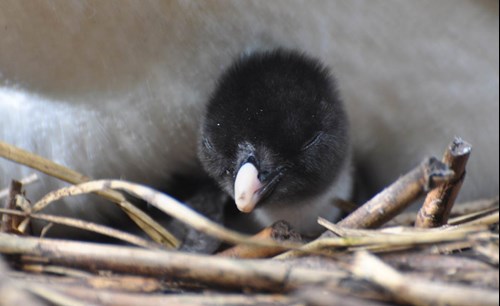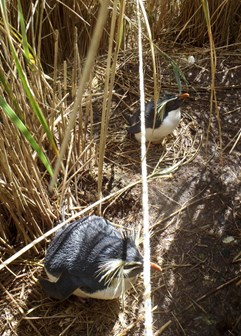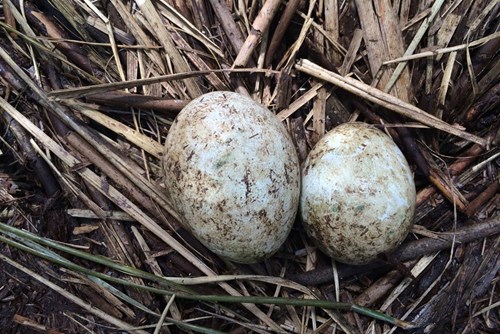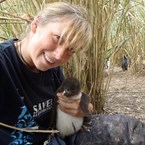Project Pinnamin - Bizarre breeding behaviours of Northern rockhopper penguins
16/05/2017 in Conservation

Above: Young Northern rockhopper chick emerging from underneath the adult - photo by Antje Steinfurth
Like all Eudyptes penguins, Northern rockhopper penguins E. moseleyi are highly synchronous breeders. Egg-laying within the Tristan da Cunha archipelago, commences towards the end of August and into September with chicks fledging in December and January. Gough Island and the Tristan da Cunha archipelago are often grouped together as the Northern rockhopper breeding site in the South Atlantic, but there is in fact some 380km in distance between them. Gough Island is actually the only Northern rockhopper breeding site south of the Sub-tropical front and in Sub-Antarctic waters. As a result the penguin’s breeding cycle commences about 3-4 weeks later than on the northern islands.
 The breeding cycle of Rockies, in fact of all crested penguins, can be broken into a number of distinct phases: incubation, guard and crèche each with well defined times of foraging and nest duties for males and females.
The breeding cycle of Rockies, in fact of all crested penguins, can be broken into a number of distinct phases: incubation, guard and crèche each with well defined times of foraging and nest duties for males and females.
During the incubation phase, females take the initial incubation shift while males generally leave a few days after the first egg is laid, staying out at sea for about 10 – 20 days. After the return of the male, the females leave and don’t return to the nest site until just before the chicks start hatching.
As the chicks begin to hatch, the guard phase begins. During this stage, the female takes sole responsibility for foraging and feeding the chicks, whilst the male remains at the nest ‘guarding’ the chick(s). Once the chicks are older, leave the nest and crèches have been formed, the male joins the female in the foraging duties.
Another unique feature of crested penguins breeding behaviour is the extreme egg-size dimorphism – a small egg (A egg) is laid first followed by a larger second (B) egg). Although they lay two eggs, they usually only raise one chick (typically the B-chick).

Above: Northern rockhopper nest containing A & B eggs - photo by Antje Steinfurth
Within AB nests (nests with both A & B eggs), the chicks emerging from B eggs are bigger and stronger (on average 60-100g) than chicks emerging from the smaller A eggs (~40-50g). We found that although there was no difference in hatching success between A and B eggs, the survival rate of B-chicks was far higher. The survival rate for the smaller chicks was found to be negatively affected by the presence of a larger sibling while the survival of the larger B chicks was not affected by whether it had a sibling or not. It is quite easy to understand why, as the bigger chicks can out-compete the smaller ones for food brought back to the nest by the mother.
This still remains one of the greatest unsolved mysteries in the animal kingdom: why would an animal bother investing in two eggs if there was never any likelihood of rearing two chicks?
Egg loss can occur for multiple reasons, for example due to predation, fights amongst penguins and even extreme weather. It is possible that the first egg might provide some minimal insurance value in the event that the larger B-egg is lost. In case where the B egg or chick is lost, our studies have shown that the smaller A egg or chick stands a good chance of survival.
Through initiatives like Project Pinnamin we hope to not only help inform conservation efforts to save this endangered species, but also build on our general understanding. There is still so much to learn about the charismatic Northern rockhopper penguin!
About the author

Antje Steinfurth
Conservation Scientist at the Royal Society for the Protection of Birds, Cambridge, UK
All photos © Antje Steinfurth
Featured Content
Featured Articles

An update from the Budongo Forest
19/04/2024 in Conservation

Edinburgh Zoo named best zoo in Scotland
15/04/2024 in Edinburgh Zoo

























Follow EZ